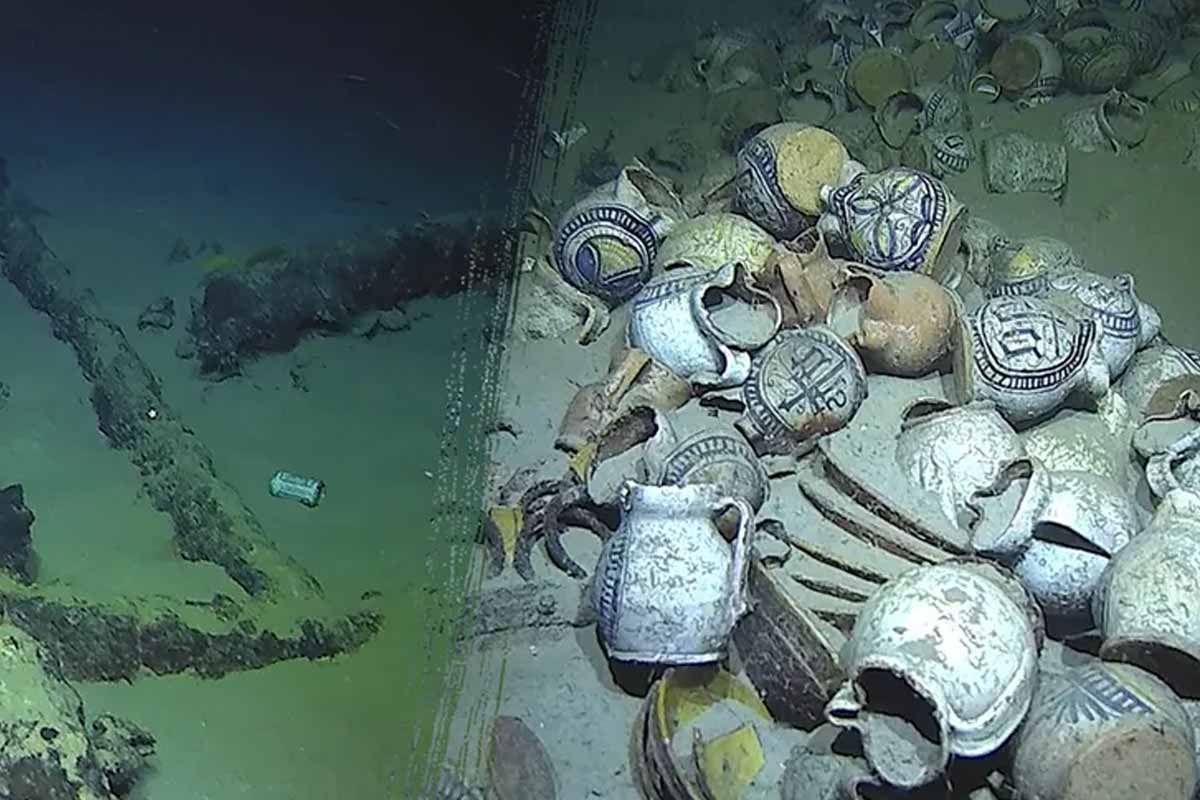A 16th-century shipwreck discovered off Saint-Tropez just rewrote what we thought possible underwater. Eight thousand four hundred twenty-one feet down, the sea kept a secret for centuries. French naval teams and archaeologists finally reached it, and the first images feel unreal. History didn’t wash away. It simply waited in the dark.
How they found it, so deep
Picture a black void at 8,421 feet, or 2,567 meters. Lights switch on. A hull emerges. Calm, eerie, intact. This is the 16th-century shipwreck discovered off Saint-Tropez, sitting where pressure crushes most equipment.
At that depth the ocean pushes more than 250 times normal atmospheric pressure. Divers can’t go there, so robots take the lead. France’s Department of Underwater Archaeological Research teamed up with the Navy. They launched remotely operated vehicles carrying 4K cameras and laser mapping rigs. Robotic arms moved like careful fingertips, nudging silt, tracing edges, lifting nothing rashly. The 16th-century shipwreck discovered off Saint-Tropez held still, as if posing for science. Three-dimensional scans stitched together a ghostly model you can orbit on a screen. Each pass revealed another detail. A plank line. An iron band. A carved curve.
France excels here, and not by accident. The country operates roughly a third of the world’s cable-laying vessels, about 33 percent. That industrial fleet sharpened the tools that now map history. For scale, compare records. Camarat 4 sets France’s depth mark. The world’s deepest shipwreck remains the USS Samuel B. Roberts at 22,621 feet. Explorer Victor Vescovo found that destroyer in the Philippine Sea, now a protected memorial.
Meet Camarat 4, frozen in time
They’ve given the site a working name: Camarat 4, after the nearby headland. The vessel is about 98 feet long. Solid lines. Balanced proportions. Not a shattered heap, but a ship that looks paused mid-voyage. Nature built a preservation chamber down there. Freezing temperatures kept microbes sluggish and hungry predators away. Absolute darkness sealed the deal. No stray glow from bioluminescent life touched these timbers. Minimal currents meant the seabed didn’t sandblast the hull. The 16th-century shipwreck discovered off Saint-Tropez survived because the sea turned gentle in the abyss.
Centuries passed. Nothing gnawed, nothing bloomed, nothing fell apart. You can trace the joinery and feel the craftsmanship, even through a screen. It’s more than a wreck; it’s a time capsule with its lid still on. The 16th-century shipwreck discovered off Saint-Tropez invites patient study, not quick trophies. Every plank whispers about the yard that built it and the crew that trusted it.
What the cargo whispers
Open the hold, and stories spill out. Nearly two hundred ceramic vessels lie stacked like sleeping birds. Floral motifs circle the clay. Crosses glow under the lights. The sacred monogram IHS appears again and again, quiet yet unmistakable. Iron bars rest in bundles wrapped with plant fibers. That wrapping mattered. Salt eats metal. The fibers bought time.
There’s ornate tableware, the fancy kind used to impress. A bronze cannon sits there, fully intact, heavy with responsibility. The ship’s anchor assembly remains complete, rigging and all. Navigation tools peek from the silt like old habits. Trade never moves just goods. It moves beliefs, tastes, rumors, and promises. This looks like a Ligurian trader working familiar Mediterranean routes. Ports nodding to ports. Families dealing with families. The 16th-century shipwreck discovered off Saint-Tropez ties those networks to real objects you can catalog.
Iron was power then, like rare earths now. Merchants treated each bar as lifeblood for cities and fleets. The 16th-century shipwreck discovered off Saint-Tropez shows how carefully they packaged strength against corrosion and chance. It’s Renaissance logistics, elegant and tough.
The sea keeps receipts
Even here, the modern world intrudes. Plastic threads drift through the beam like synthetic jellyfish. A stray aluminum can flashes back at the camera, bright and out of place. Old fishing nets snag the seafloor, dangerous and stubborn. We like to believe the deep is untouched. It isn’t. Our habits travel farther than we think. Wood-eating organisms barely survive at these depths, which helps the timbers endure. That’s the good news.
The bad news is the trash got here anyway. Camarat 4 endured centuries of silence, then met our noise. The 16th-century shipwreck discovered off Saint-Tropez now shares space with plastic, which doesn’t rot or repent. It’s a jolt, and maybe a nudge. If we want the past to speak, we need to stop shouting into the ocean.
What comes next
No rush to hoist treasures. That’s not the plan. Teams will send robots back with gentler touch and sharper eyes. Select artifacts will rise for lab study, not spectacle. Most knowledge will come from images and maps, frame by careful frame. Three-dimensional models will let researchers revisit the site without stirring the silt.
Shipwrights will read the hull like a ledger. Historians will trace trade routes from pottery patterns and iron bundles. Conservators will test how darkness and cold preserved fibers and pitch. Engineers will refine tools for the next descent. The 16th-century shipwreck discovered off Saint-Tropez becomes both classroom and compass.
It points toward better methods and deeper patience. Future dives will move slowly, like librarians in a fragile archive. There’s excitement in that restraint. A record fell, yes, but the real prize is understanding. We get to see Renaissance commerce without the filter of ruin. We get timbers that still hold their shape and stories that still hold their breath. And we get a clear message from the deep: keep listening, and keep your footprints light. The 16th-century shipwreck discovered off Saint-Tropez waited for us. Now it asks for care equal to our curiosity.
